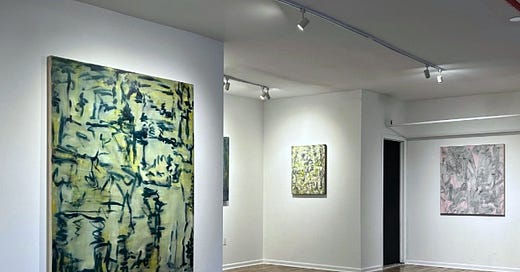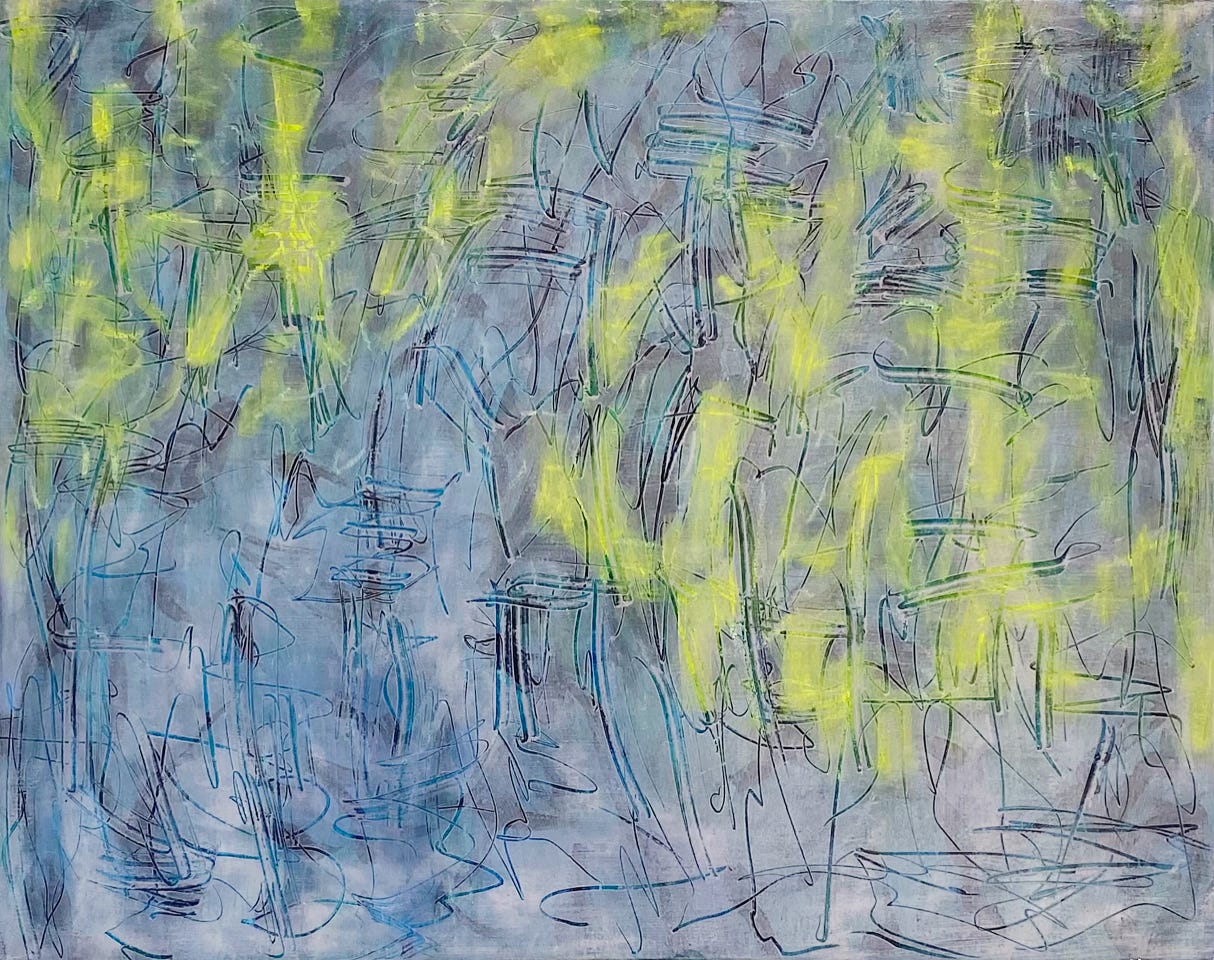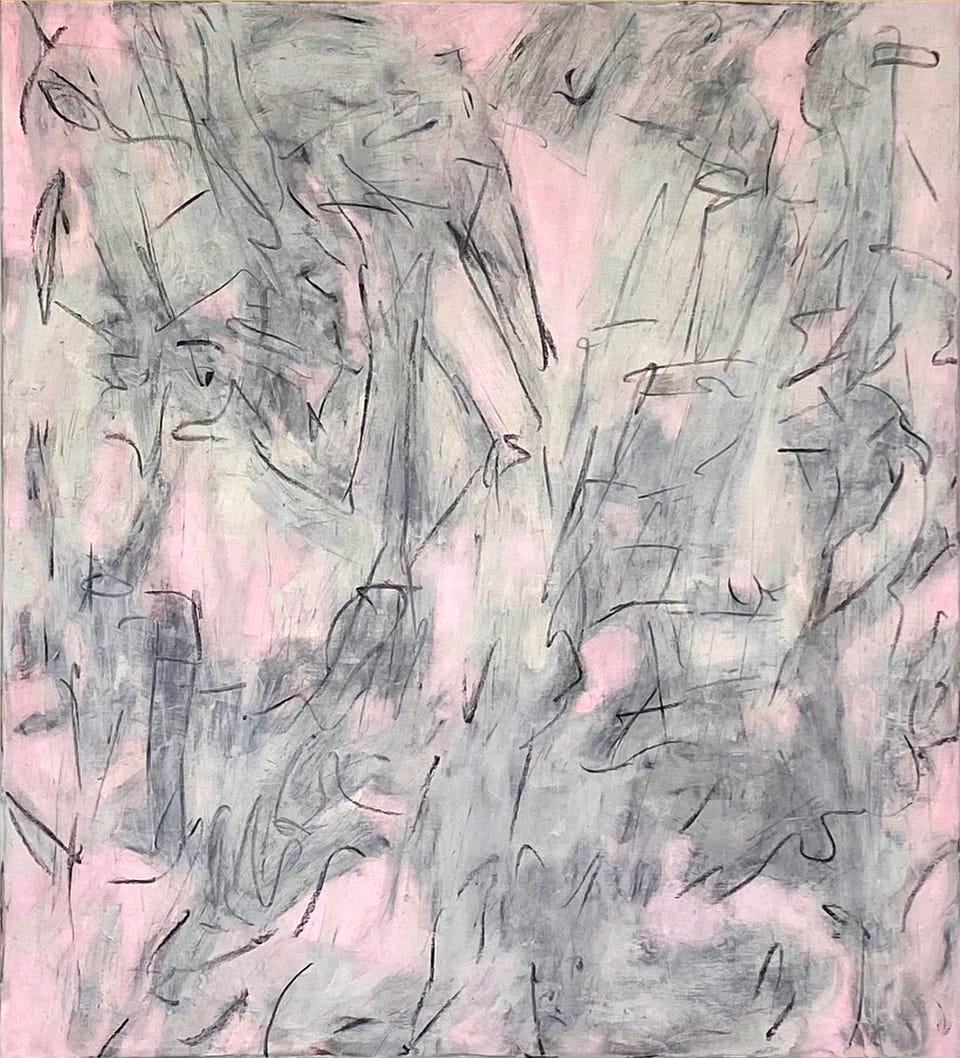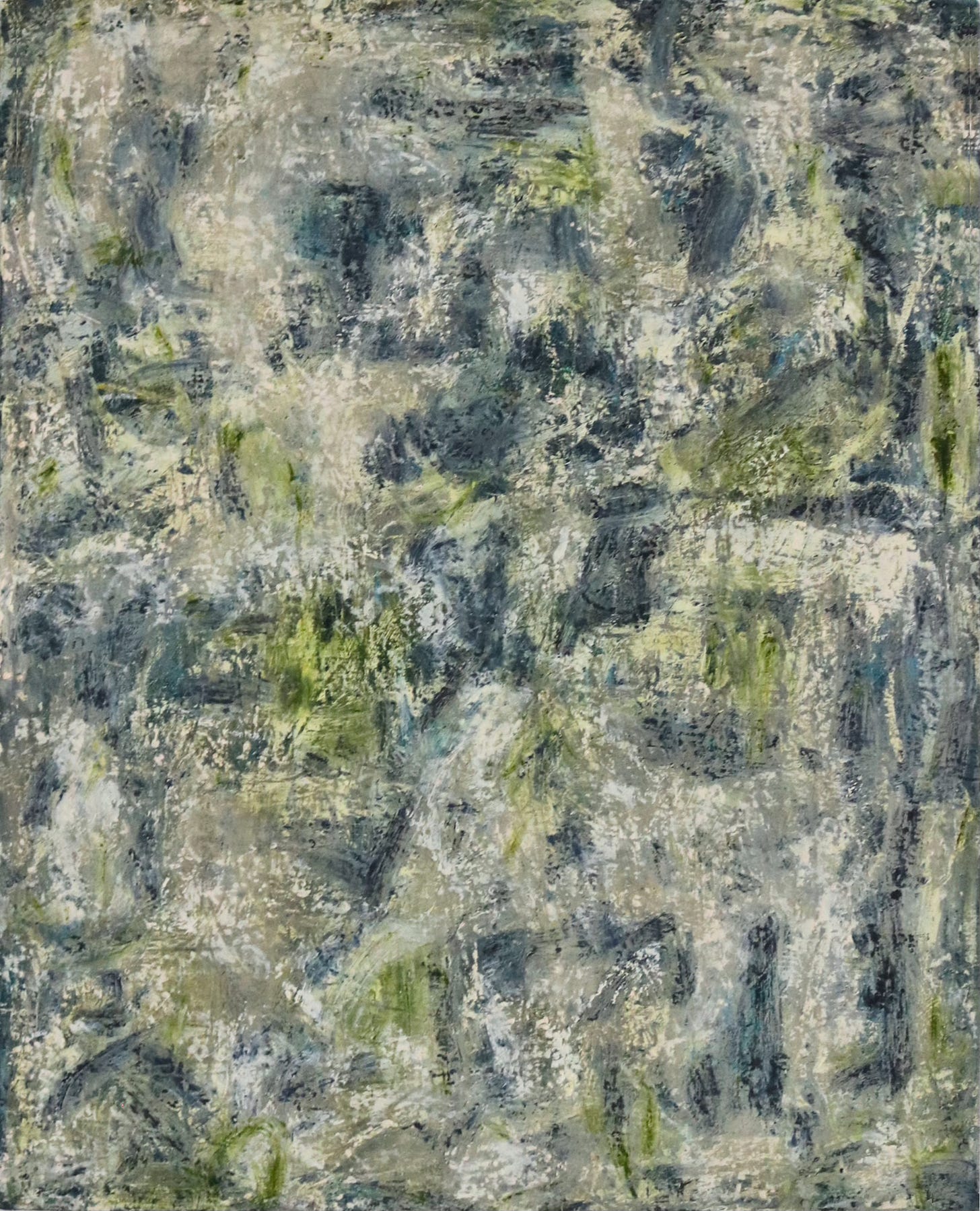A few weeks back, I posted an old review of a Claire Seidl exhibition held in 2023 at Brooklyn’s One Grand Army Plaza, curated by Fran Kaufman. Failing at the time to pitch it successfully to a review venue, I left the full review on my hard drive for two years. A current exhibition of Seidl’s work, Days Like These, at Helm Contemporary in NYC , curated by Karina Argudo, gave me another chance to investigate the work of a painter I find unusually prolific, adventurous, and subtle—a rare combination. During our conversation, I asked Claire a number of technical questions I had prepared prior to our wide ranging panel discussion at Helm on March 15 with Laurie Gwen Shapiro. The following is a transcript of that conversation, edited for clarity.
PM - Looking at the painting, “Days Like These”, I see drawn elements that seem calligraphic in the upper region of the picture, and elements drawn with an implied perspective in the lower. Below those are elliptical outlines like those of shadows on a horizontal plane. Does that sequence reflect a recognition of pictorial space you addressed from the start of the painting, or something that developed organically?
CS - Because I work out from the ground, in layers, there is always a perceived middle ground and foreground. In essence, this is pictorial space, which is a reflection of the way we perceive things in real life. In “Days Like These”, there is a sense of perspective from the ground up between the two yellow areas on the top.
It's so interesting how you picked the only painting in the show that uses perspective to move the eye around! The effect came about in the process of making the painting. I wanted the yellow areas or forms to break up the overall feel. The ground, with grays and violets over turquoise, was already drawn into with the end of my paintbrush. This drawing also revealed a yellow layer below when I scraped through.
The only way I could bring the yellow spheres, and the ground together was to draw vertical lines falling down between the spheres and moving out towards the right, where you noticed the horizontal drawing elements. In my work, perspective builds as the layers build up from the ground. There is a real background, middle ground and foreground in most of my paintings. It represents both pictorial space and the way we see things in real life.
PM - Do you understand the transformation from a literal two, to an implied third dimension in “Days Like These” as clarification of the painting’ strategy, or was it a spontaneous change made during the addition of the final layer?
CS - As I said, the paintings take on their spatial form during the process of layering and drawing. It does not occur only at the end. More importantly, I don’t see it as strategy. I don’t plan out my paintings in any way. This is true of the way I draw as well. Some viewers are reminded of calligraphy in my drawing, but it is just drawing – also known as asemic drawing or white writing. It’s direct, unedited, and free-wheeling.
PM - After engaging with two all-encompassing exhibitions of your work, here at Helm this month and in 2023 at the show Fran Kaufman curated at One Grand Army Plaza, I can’t dispel the thought that your work reveals a tendency, perhaps a reliance, on that overall look most would associate with mid-century abstraction. Are there any painters from that period whose work informs your method? I ask this because the decision to accept the picture as complete, or having attained its ideal realization, especially an abstract picture, requires some preconception of what a finished picture looks like.
CS - I have been looking at art my whole life and making abstract paintings since high school. My methods are both everyone’s I’ve seen and my own.
I would mention Lee Krasner’s black and white paintings, especially what she called “The Little Paintings”, in which she employed her own kind of calligraphy in non-hierarchical, overall compositions. Jackson Pollock’s black and white paintings and drawings, along with those of Perle Fine, whose agitated line and drawn brushed strokes appeal to me. I always liked Sonia Getchoff’s work for its strong forms and color. Joan Mitchell’s early paintings struck a note with me, especially the ones I feel presaged Susan Rothenberg. I’d add Rebecca Purdham’s brushstroke, Brice Marden’s lyrical lines and color, Louise Fishman’s sturdy marks and structures, and her go-for-broke way of finishing her paintings. And Bill Jensen’s wild juxtapositions of paint. More recently, I am liking Julie Mehretu’s and Amy Sillman’s paintings.
I don’t think my individual paintings have so much variety within each one, but to me, they look quite different from each other. One painting may have a lot of texture (which is the result of it not resolving in early layers) while another can consist of only a couple of layers and be quite thin. I restrain my color to emphasize the drawing and its resultant forms and sense of space.
Each painting is like a stubborn individual that belongs to the same family. They are definitely related to one another but they are not the same, nor are they part of a deliberate series.
For me, a painting could be finished when all the formal elements are held in equipoise, and I have learned that this can happen at any time in the process. I have no preconceived idea of when that might be and no idea of what the painting will look like. I don’t aim for an overall look but neither do I avoid it if it happens. Though the formal elements must work together, the painting has to make sense in its entirety and convey or communicate something to the viewer. It is never only about formal elements working together.
PM - Would you agree then that your paintings require a considerable knowledge of abstract painting’s history?
No. I don’t agree. Many different people look at my paintings and find things to see. They don’t need to know about abstract painting. They do need to take the time to look, and see, and experience what they perceive. It helps if they wonder about their reactions and try to point to what the artist does to trigger those reactions. I only ask that they don’t try and attach things from the real world to the paintings, and vice versa.
Viewers don’t require directions. One of my titles is, “I’m Not Going to Draw You a Map” .
PM - Because each layer of working surface remains somewhat visible in each painting’s final condition, do you believe the stages of each painting’s construction can be read by a viewer who has not followed the painting’s evolution as you did?
CS - Yes, I think a viewer can see the layers and progression. But, they don’t have to read them as if they are in a particular order - it’s not necessary.
PM - Does the fact that many of your titles are idiomatic expressions (How on Earth, All Told, In Light of Everything – basically word abstractions) indicate an extending of the painting’s spontaneous process as a challenge to the viewer? And if so, is it meant as an invitation to complete the work, as Duchamp suggested, or leave the viewer in the same labyrinth you presumably travelled through when you decided you could go no further?
CS - I don’t know what a word abstraction is, but my titles are cliches, idioms, and everyday sayings. Their meaning is refreshed by being placed in a new context. I don’t intend the titles to challenge the viewer, and they certainly do not complete the work. I finish the work when I am out of the labyrinth, as you call it. I never think I can’t go further. I just stop when it is finished, that is when I feel I don’t need to go any further. The painting is finished when I feel I’ve gone as far as I think I should.
Claire Seidl - Days Like These
Helm Contemporary
February 26 - March 28, 2025
312 Bowery - 3rd floor
New York, NY 10013
Tues – Fri | 11 am-6 pm
Sat | 11 am - 5pm
212 321-0743
Karina Argudo - director







